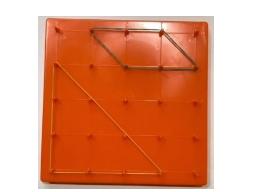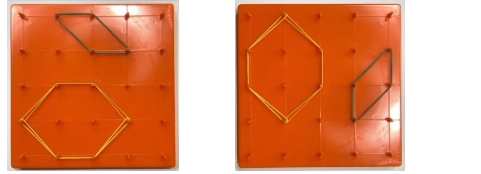General Information
Benchmark Instructional Guide
Connecting Benchmarks/Horizontal Alignment
Terms from the K-12 Glossary
- Hexagon
- Octagon
- Pentagon
- Polygon
- Rectangle
- Square
- Triangle
Vertical Alignment
Previous Benchmarks
Next Benchmarks
Purpose and Instructional Strategies
The purpose of this benchmark is to build on the work of grade 1 by including the task of drawing specific two-dimensional figures based on a defined attribute. At this grade level, five- and eight-sided figures have been included and a ruler would be used to create straight edges.- Instruction includes experience with a variety of examples and non-examples that lack a defining attribute.
- Instruction includes defining attributes such as numbers of sides, sides of equal length or number of vertices, whether they are closed or not and whether the edges are curved or straight.
Common Misconceptions or Errors
- Students may misidentify a figure based on a non-defining attribute.
- Students may not recognize figures that have been rotated or that are irregular.
Strategies to Support Tiered Instruction
- Teacher provides a geoboard for students to make a series of closed shapes, following instructions like make a closed shape with three straight sides and three corners or a closed shaped with 5 straight sides and 5 corners. Students use the geoboard and draw a picture of the shape. Teacher asks questions like, “How did you know to make this shape?” to draw attention to the defining attributes. It may be helpful to have students compare their shapes with other students.
- Example:

- Teacher provides a geoboard to make a series of closed shapes (i.e., a closed shape with three straight sides and three corners, a closed shaped with 5 straight sides and 5 corners).
- For example, students draw a picture of the shape. Teacher asks questions like, “How did you know to make this shape?” to draw attention to the defining attributes. Teachers may limit the type of shapes students work with at this level.
- Instruction includes opportunities to build shapes on a geoboard as the teacher calls out defining attributes (i.e., “make a two-dimensional figure with three vertices”). After creating a correct figure, the teacher has students rotate the geoboard 90 degrees to see that it is still the same figure.
- Example:

- Teacher provides similar instruction from above but limits the amount and types of shapes students build on a geoboard (i.e., only build a square or triangle).
Instructional Tasks
Instructional Task 1 (MTR.4.1)
Provide pairs of students with figure cards, geoboards and rubber bands. Students will play a game of “describe and build” to support identifying figures.- Part A. Partner A uses the figure card to describe a two-dimensional figure. As Partner A describes the figure, Partner B uses the geoboard to construct the figure that is being described. Neither partner should be able to see each other's card or geoboard.
- Part B. Once Partner B has constructed the figure based on the defining attributes, the partners finish by comparing the figure on the figure card to the figure that was created. Discussion should include language about specific defining attributes.

Enrichment Task 1
Part A. Partition a regular hexagon into two or three equal parts.Part B. Partition a regular octagon into two, four or eight equal parts.
Instructional Items
Instructional Item 1
Which word best identifies the figure below?
- a. Triangle
- b. Pentagon
- c. Hexagon
- d. Square
*The strategies, tasks and items included in the B1G-M are examples and should not be considered comprehensive.
